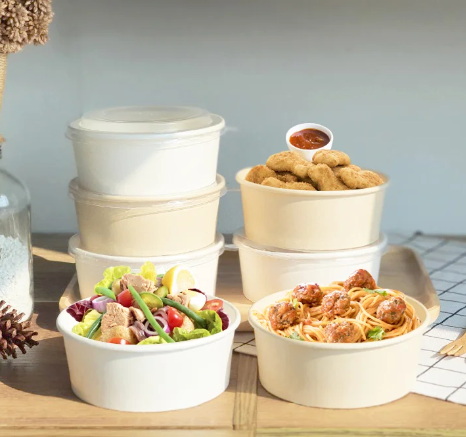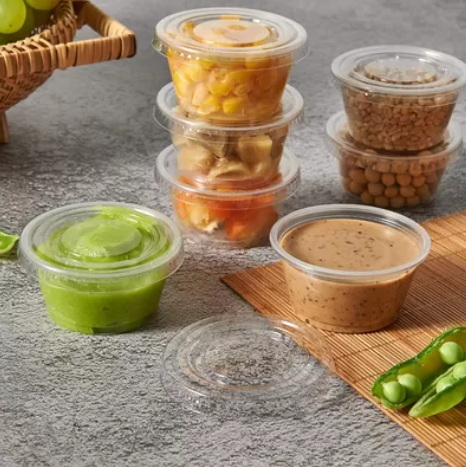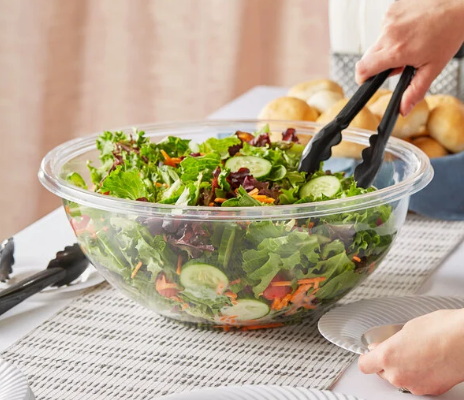
Content Menu
● Introduction to Quality Control in Disposable Plastic Bowl Production
>> Raw Material Selection
>> Production Process Control
● Quality Assurance Measures
>> In-Process Checks
>> Post-Production Testing
● Packaging and Shipping
● Certifications and Compliance
● Continuous Improvement
● Regulatory Environment
● Technological Advancements in Plastic Manufacturing
>> Thermoforming
>> Injection Molding
● Safety Considerations
>> Chemical Migration
>> Heat Resistance
● Environmental Impact
● Conclusion
● Frequently Asked Questions
>> 1. What materials are commonly used for disposable plastic bowls?
>> 2. How do manufacturers ensure the hygiene of disposable plastic bowls?
>> 3. What certifications are important for disposable plastic bowl manufacturers?
>> 4. How do manufacturers handle customer feedback for quality improvement?
>> 5. What role does packaging play in maintaining product quality?
● Citations:
Disposable plastic bowls have become an integral part of modern life, particularly in the food service industry. They offer convenience, cost-effectiveness, and ease of use. However, ensuring the quality of these products is crucial to maintain consumer trust and safety. In this article, we will delve into the processes and strategies that disposable plastic bowl producers employ to guarantee high-quality products.

Introduction to Quality Control in Disposable Plastic Bowl Production
Quality control in the production of disposable plastic bowls involves a comprehensive set of processes designed to ensure that every product meets specific standards of safety, durability, and performance. This includes rigorous inspections at various stages of production, from raw material selection to final product testing.
Raw Material Selection
The first step in ensuring quality is the selection of raw materials. Manufacturers must choose plastic materials that are food-grade and compliant with health and safety regulations. Common materials used include polypropylene (PP), polystyrene (PS), expanded polystyrene (EPS), and polyethylene terephthalate (PET)[1]. Each material has its own set of properties and characteristics that impact the safety and durability of the final product.
For instance, polypropylene (PP) is known for its excellent heat resistance and durability, making it suitable for hot foods. On the other hand, polystyrene (PS) is more commonly used for cold foods due to its lower heat resistance[1][7]. The choice of material depends on the intended use of the bowl, such as whether it will be used for hot or cold foods.
Production Process Control
Once the raw materials are selected, they undergo a series of transformations through processes like extrusion, injection molding, and thermoforming. The production environment must be controlled to prevent contamination and ensure that all equipment meets health and safety standards.
Production Line Overview:
Manufacturers use advanced technologies such as automation to streamline production processes. Automation allows for real-time monitoring of production parameters, ensuring precision and consistency in every product[2]. This not only enhances efficiency but also reduces the margin of error, leading to higher quality products.
Quality Assurance Measures
Quality assurance is a proactive commitment to ensuring that every product meets both industry standards and customer expectations. This involves implementing strict quality control protocols throughout the production process.
In-Process Checks
During production, real-time inspections are conducted to catch any deviations early. Parameters such as temperature, pressure, and tool integrity are monitored to maintain precision. These checks are crucial in preventing defects and ensuring that products meet quality standards.
Post-Production Testing
After production, products undergo thorough testing, including mechanical strength tests and visual inspections. These tests ensure that the products are durable and compliant with industry standards. For example, manufacturers may conduct drop tests to assess the impact resistance of the bowls.
Packaging and Shipping
The packaging of disposable plastic bowls is also crucial to ensure their quality during transportation. Packaging materials must be food-grade and designed to prevent damage and contamination. Proper packaging helps maintain the integrity of the products, ensuring they reach customers in perfect condition.
Certifications and Compliance
Manufacturers often obtain certifications such as ISO 22000 and FSSC 22000 to demonstrate their commitment to quality and safety. These certifications ensure that production processes adhere to international standards for food safety. Compliance with these standards is essential for maintaining consumer trust and ensuring regulatory compliance.
Continuous Improvement
To maintain high-quality standards, manufacturers continuously solicit feedback from customers and stakeholders. This feedback helps identify areas for improvement and innovation. By incorporating customer insights into production processes, manufacturers can refine their products and meet evolving consumer needs.
Regulatory Environment
The regulatory environment for disposable plastic products is evolving, with many regions implementing bans or restrictions on certain types of plastic tableware. For instance, some jurisdictions have banned the sale of expanded polystyrene (EPS) tableware due to environmental concerns[4]. Manufacturers must stay informed about these regulations to ensure compliance and adapt their production processes accordingly.
Technological Advancements in Plastic Manufacturing
The landscape of plastic manufacturing is rapidly evolving with advancements in sustainable fabrication methods and new molding technologies. These innovations have improved the efficiency and precision of production processes, enabling manufacturers to produce more versatile and durable products[2].
Thermoforming
Thermoforming is a key process in creating high-quality disposable bowls. By heating thermoplastics until they become pliable, manufacturers can mold them into precise shapes using various techniques. This method is highly versatile, allowing for the production of bowls that meet specific design requirements for different applications, especially in food packaging[3].
Injection Molding
Injection molding is another critical technique used in plastic manufacturing. It involves injecting molten plastic into a mold to create precise shapes. This process is widely used for producing complex designs with high precision and is essential for creating durable plastic bowls.

Safety Considerations
Safety is a paramount concern in the production of disposable plastic bowls. Manufacturers must ensure that their products are free from harmful chemicals such as BPA and phthalates, which have been linked to health risks[7]. Additionally, bowls must be designed to resist leaching, especially when used with acidic or high-temperature foods.
Chemical Migration
One of the primary safety concerns with plastic containers is the migration of chemicals into food. This can occur when the plastic interacts with certain types of food, especially under high temperatures. Manufacturers must conduct thorough tests to ensure that their products meet safety standards for chemical migration[1][5].
Heat Resistance
Plastic bowls must also be heat-resistant to prevent deformation or chemical leaching when exposed to hot foods. Polypropylene (PP) is often preferred for hot foods due to its excellent heat resistance properties[7]. Ensuring that products are microwave-safe is also crucial to prevent accidents and maintain consumer safety.
Environmental Impact
The environmental impact of disposable plastic bowls is a growing concern. Manufacturers are increasingly focusing on sustainable production methods and materials that are more environmentally friendly. This includes the use of bioplastics and recyclable materials to reduce waste and minimize environmental harm.
Conclusion
Ensuring the quality of disposable plastic bowls is a multifaceted process that involves rigorous quality control measures, ethical sourcing practices, and continuous improvement initiatives. By adhering to these standards, manufacturers can deliver products that not only meet but exceed customer expectations while ensuring safety and sustainability.

Frequently Asked Questions
1. What materials are commonly used for disposable plastic bowls?
Disposable plastic bowls are typically made from food-grade materials such as polypropylene (PP), polystyrene (PS), expanded polystyrene (EPS), and polyethylene terephthalate (PET)[1].
2. How do manufacturers ensure the hygiene of disposable plastic bowls?
Manufacturers ensure hygiene by using clean production environments, implementing strict quality control measures, and selecting raw materials that meet health and safety standards.
3. What certifications are important for disposable plastic bowl manufacturers?
Certifications like ISO 22000 and FSSC 22000 are crucial as they ensure that production processes comply with international food safety standards.
4. How do manufacturers handle customer feedback for quality improvement?
Manufacturers collect feedback from customers and stakeholders to identify areas for improvement. This feedback is used to refine production processes and innovate new products.
5. What role does packaging play in maintaining product quality?
Packaging plays a critical role in preventing damage and contamination during transportation. Manufacturers use food-grade packaging materials to ensure the integrity of the products.
Citations:
[1] https://www.cfs.gov.hk/english/programme/programme_rafs/programme_rafs_fc_01_03_dp.html
[2] https://www.piedmontplastics.com/blog/plastic-manufacturing-technology
[3] https://www.onebmg.com/our-markets/quick-serve/bowls
[4] https://www.info.gov.hk/gia/general/202310/18/P2023101800622.htm
[5] https://pmc.ncbi.nlm.nih.gov/articles/PMC11193405/
[6] https://www.starrapid.com/blog/the-top-7-ways-of-forming-plastics/
[7] https://customcupfactory.com/blogs/news/are-plastic-soup-containers-safe-best-practices-for-ensuring-customer-safety
[8] https://ourworldindata.org/plastic-pollution
[9] https://www.info.gov.hk/gia/general/202303/15/P2023031500554.htm
[10] https://www.nature.com/articles/s43247-023-00982-4
[11] https://www.legco.gov.hk/research-publications/english/essentials-2021ise22-measures-to-curb-disposable-plastic-tableware.htm
[12] https://food.chemlinked.com/news/food-news/hong-kong-implements-the-first-phase-disposable-plastic-tableware-regulation
[13] https://www.epd.gov.hk/epd/english/environmentinhk/waste/pro_responsibility/index.html
[14] https://www.lifecycleinitiative.org/wp-content/uploads/2021/03/UNEP-D001-Tableware-Report_Lowres.pdf
[15] https://www.epd.gov.hk/epd/sites/default/files/epd/english/environmentinhk/waste/pub_consult/files/tableware-con-doc-en.pdf
[16] https://www.science.org/doi/10.1126/sciadv.1700782
[17] https://business.gov.nl/sustainable-business/environment/single-use-plastics-these-are-the-rules/
[18] https://www.digitalpolicy.gov.hk/f/papersformeeting/7693/FRSTF_Paper_102_EN.pdf
[19] https://www.nea.gov.sg/our-services/waste-management/3r-programmes-and-resources/reducing-our-use-of-disposables
[20] https://cuttheplastics.hk/images/download/Catering%20Sector.pdf

















